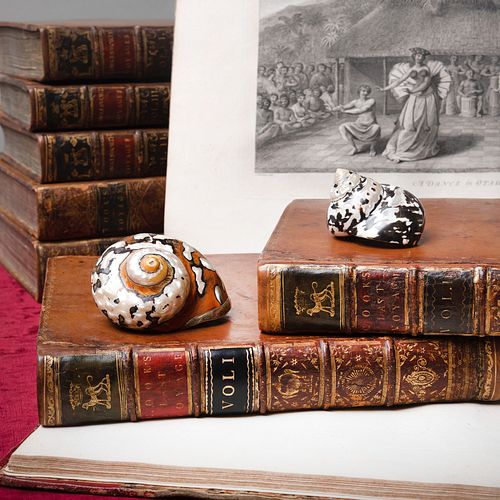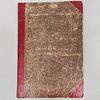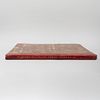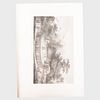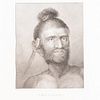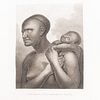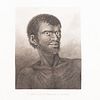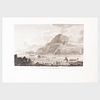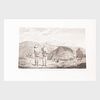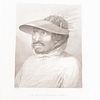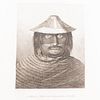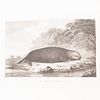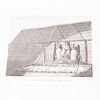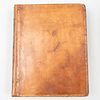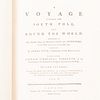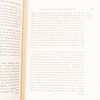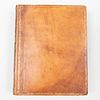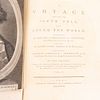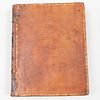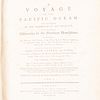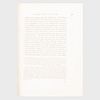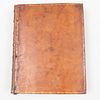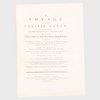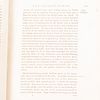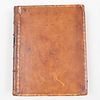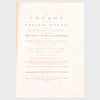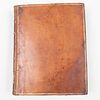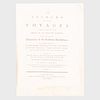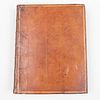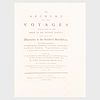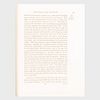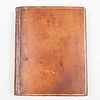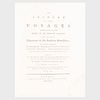COOK, Capt. James (1728-1779): A Set of Three Voyages
Bid Increments
| Price | Bid Increment |
|---|---|
| $0 | $25 |
| $200 | $50 |
| $500 | $100 |
| $3,000 | $250 |
| $5,000 | $500 |
| $10,000 | $1,000 |
| $30,000 | $2,500 |
| $100,000 | $5,000 |
London: 1773-1784.
Comprising:
[First Voyage], HAWKESWORTH, John. An Account of the Voyages Undertaken by the Order of His Present Majesty for making Discoveries in the Southern Hemisphere, And successively performed by Commodore Byron, Captain Wallis, Captain Carteret, and Captain Cook, In the Dolphin, the Swallow and the Endeavour, London: W. Strahan, 1773. Three volumes with engraved plates, charts and maps. First edition. Brown leather boards with gilt raised spines. With book plates from Carton Library. Volume I inscribed 'Duke of Leister/Lyons Set'.
[Second Voyage], COOK, James, A Voyage towards the South Pole, and round the World. Performed in His Majesty's Ships the Resolution and Adventure, in the years 1772, 1773, 1774, and 1775...In which is included, Captain Furneaux's Narrative of his Proceedings in the Adventure during the Separation of the Ships. London: W. Strahan and T. Cadell, 1777. Two volumes with engraved plates, charts and maps. First edition. Brown leather boards with gilt spines.
[Third Voyage], COOK, James, A Voyage to the Pacific Ocean. Undertaken, by the command of His Majesty, for making Discoveries in the Northern Hemisphere. To determine The Position and Extend of the West Side of North America; its Distance from Asia; and the Practicability of a Northern Passage to Europe. London: G. Nicol, 1784. Three volumes with engraved plates. First edition. Brown leather boards with gilt raised spines.
Together with Plates to Captain Cooks Voyages, marble paper boards with red leather gilt titled spine.
Note: The only 18th century explorer to lead more than one Pacific voyage, Captain James Cook embodied the spirit of the great age of maritime discovery. Cook's achievements in mapping the Pacific, New Zealand and Australia changed Western perceptions of world geography. His seamanship, navigational and cartography skills set new standards and sealed his place in history as one of the world's most innovative and talented maritime explorers. Cook made three circumnavigations between 1768 and 1776, observing on his first voyage aboard the Endeavour the Transit of Venus in Tahiti, rediscovering and charting New Zealand, and discovering the eastern coast of Australia. Several of the charts and maps he made were strategically important, including the Chart of the Straight of Magellan. On his second voyage, aboard the Resolution with a consort ship named the Adventure, Cook crossed the Antarctic Circle for the first time and disproved the existence of the 'Great Southern Continent.' Cook charted Tonga and Easter Island, discovered New Caledonia in the Pacific, and the South Sandwich Islands and South Georgia Islands in the Atlantic. Upon his return to England, he was promoted to captain, elected a fellow of the Royal Society and awarded the gold Copley Medal. On his third voyage, Cook was charged with finding a North-West passage between the Atlantic and the Pacific. Although the passage had been sought in vain from Europe, Cook endeavored to find a route from the North Pacific. Aboard the Resolution for this voyage, Cook was not able to find a passage usable by sailing ship but discovered the Hawaiian Islands where he met his death in a skirmish on the beach at Kealakekua over the theft of a cutter. Cook's legacy as a navigator, explorer and cartographer remains unsurpassed in maritime history and his thoroughness in the care of men at sea was unmatched. Cook's crew were remarkably healthy and none died of scurvy which notoriously decimated seamen on lengthy voyages in the 18th century. Cook insisted on cleanliness and ventilation in the crew's quarters, and ensured a healthy diet of foods containing ascorbic acid to ward off the disease. Volume II of Cook's Second Voyage includes a fascinating discourse on 'Some Late Improvements of the Means for Preserving the Health of Mariners' which includes Cook's research on the prevention of scurvy and other issues relating to the well-being of men at sea. As one of only a few men from humble beginnings to rise through the ranks of the 18th century British Navy, Captain Cook was particularly sympathetic to the needs of ordinary sailors, and was interested in the daily life, language and culture of the indigenous peoples he encountered. Captain James Cook changed the map of the world in many ways that remain significant today.

